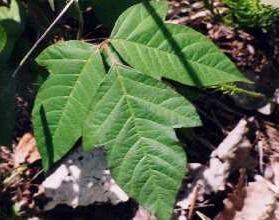
By Jennifer Anderson Scientific name: Toxicodendron radicans, previously called Rhus radicans. Description: The leaves are alternate and compound, with 3 leaflets. The end leaflet is long-stalked, whereas the side ones are almost stalk less. It also has a pointed tip. The leaflets are usually more than 3 cm in length. The leaves are extremely variable and can range from smooth to toothed or lobed edges, from stiff and leathery to thin, and from hairy beneath to no hairs at all. The color of the leaves varies from shiny to dull green, and in young or dying leaves they may have a reddish tint to them. They turn red-gold in color in autumn. Poison ivy fruit is round, smooth, approximately 3/16 inch in diameter, pale green to grayish white in color, clustered, mature from August through October and persist. Flowers grow in small branching clusters in the axils, yellowish to greenish, approximately 1/8 inch in diameter, blooming from May through July. Poison Ivy grows as a shrub or vine. Shrubs can grow erect and bushy. The woody vine can trail, straggle, or scramble over rocks. It can climb high due to aerial rootlets on its stems, and attain a 15 cm diameter to its trunk. These climbing vines have fibrous, hair like rootlets that attach to tree bark or other objects and look like fuzzy ropes. Habitat: Poison ivy can be found from Poison ivy is a pioneer species, growing and reproducing quickly using large amounts of sunlight from open areas such as old fields, and forest gaps. A hurricane, death of a large tree, fire or other disturbance can cause such forest gaps, or openings, which let a lot of light in. Therefore, likely locations include wooded areas, thickets, roadsides, clearings, fence rows, and meadows. Poison ivy is moderately shade tolerant, however full sunlight in such areas encourages lush, dense growth. Poison ivy is an indicator species of Northern and Southern Riverine Forests, and can also be found in fore and back dunes of coastal areas and edges of rivers. Poison ivy is abundant in Other Facts: Poison ivy is an important food source for wildlife. Poison ivy produces low quality fruit, that which is low in lipid content. Migrating birds in the fall eat some of the berries; however they feed mostly on high quality fruits, those with high lipid content. This leaves berries for the winter resident bird species to feed on when other foods are scarce. Small bees and flies pollinate the flowers in the spring. Insects feed on the plant, and caterpillars from moths feed on the leaves. Larval insects spin silk to roll and fold the leaves of poison ivy over to enclose them for the pupa stage. All parts of poison ivy contain a dangerous skin irritant which is poisonous to the touch at all seasons. Between 8 and 48 hours after touching the plant or coming in contact with other objects that have touched the plant, a rash develops from an allergic reaction to urushiol which is the poison ivy oil. The rash is red and looks like lines or streaks and has bumps that are filled with fluid, or large areas that are raised. This rash is uncomfortable and itchy. It is not contagious, however, and can only be spread through contact with more urushiol, not by touching the rash or fluid from the blisters. Wet compresses, taking a cool bath, and applying calamine lotion will help sooth the rash. Treatment by a health professional may be necessary if the rash is moderate or severe, or if infection occurs. To help prevent infection avoid scratching the rash. To prevent exposure while visiting Do not touch these plants, or make contact with them with your clothing, hat or backpack. Long pants, enclosed shoes, long sleeves, and vinyl gloves can help create a barrier between the plant and your skin. If your skin has been touched by poison ivy wash it immediately with water. The sooner you can do this the better; however, you may still be able to wash your skin for up to 4 hours after contact, which may help prevent your skin from breaking out later with a rash. When you get home, carefully put your clothes in the washer, while avoiding touching the clothing parts that may have the plant oil on them. Have a great visit to this park and stay poison ivy free! References and Links: Eastman, John. 1992. The Book of Gleason, Henry A.1952. Illustrated Flora of the Grimm, William Carey. 1993. The Illustrated Book of Wildflowers and Shrubs. Stackpole Books, Kricher, John C., and Gordon Morrison. 1988. Eastern Forests, Peterson Field Guides. Houghton Mifflin Company, Newcomb, Lawrence. 1977. Newcomb’s Wildflower Guide. Little, Brown and Co., Petrides, George A.1972. A Field Guide to Trees and Shrubs, Peterson Field Guides. Houghton Mifflin Company, Radford, Albert E., Harry E. Ahles, and C. Ritchie Bell. 1968. Manual of the Vascular Flora of the Strausbaugh, P.D., and Earl L. Core. nd. Flora of Further information can be found: Integrated Taxonomic Information System (ITIS) Report U.S. Department of Agriculture. Germplasm Resource Information Network database which is sponsored by the Agricultural Research Service, U.S. Department of Agriculture. PLANTS National Database, a website supported by the Natural Resource Conservation Service. |
Last updated: February 26, 2015
